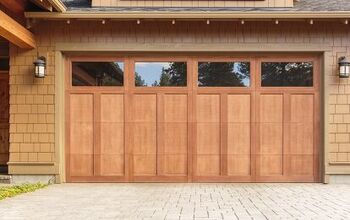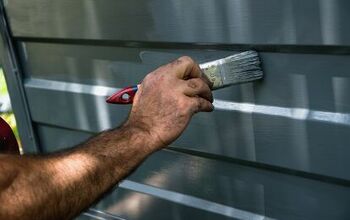Can Snakes Get Under Garage Doors? (Find Out Now!)

Rodents and insects are simply a part of life. That also includes the need to deal with them, especially when those unwanted vagrants are vermin, such as snakes. Which also makes us wonder, how do these pests and potentially dangerous animals get into our homes and garages? Sure, we know that insects are nearly unstoppable, but how do those other critters get inside? Can snakes get under garage doors?
No, if your garage door works correctly, then snakes will not be able to get under it. The natural weight of garage doors prevents snakes from getting under the door. Additionally, many garage doors also have stoppers or some kind of runner material on the bottom. These features are used to prevent water from coming in, along with air and even snakes.
That doesn’t mean, however, that snakes don’t get in and can’t get in. Like any wild animal, or in this case, reptile, all they need is an opportunity. Here are the areas that should be checked if you have had a snake inside your home or garage, or if you don’t want them inside.
Do You Need Pest Control Services?
Get free, zero-commitment quotes from pro contractors near you.

How Can Snakes Get Into the Garage or House?
Among all the unwelcome trespassers, from rats and raccoons to spiders and snakes, snakes are particularly disliked. Worse still, they are also one of the more dangerous creatures. Like defending against any enemy, it is a good idea to understand how they operate. In the case of snakes, getting in that will mean knowing how and where that does and can happen.
Garage Doors
While snakes are unable to penetrate or get under garage doors that shut correctly, the opposite may be true for those that don’t. A garage door that doesn’t close completely is akin to a welcome sign for snakes and rodents. The same is true for garage doors that don’t create a seal along the side of the garage.
To find out if there is a hole or entry around your garage door, you can do a light test. During a bright day simply go inside the garage and close the doors. It might be helpful to block out any light from windows too. Now, make sure any garage lights are turned off, and look for signs of sunlight coming through the garage door.
If there is light, then there is space, and that means there is an entrance for a snake and others. While garages are common entryways for snakes, there are also other places they can enter.
Siding and Brick Gaps
If a home has siding, then any gaps, such as those that may develop between the veneers, can avail an entry for snakes. Additionally, bricks that have lost or that are missing mortar are also possible doorways for snakes to get in. Snakes are shockingly flexible and nimble. That means a crack or hole that doesn’t look big enough for any animal to get into a snake probably can.
The easiest solution and most certain way to fix this potential problem is to inspect the outside of the home. Then, after locating any issues with the exterior, proceed to fix the problems. The golden rule is that if snakes don’t have an entrance, they won’t force their way inside.
During the outside inspection of the house is also a good time to take note of any issues with other windows or doors. Any windows that are closed all the way or door frames that aren’t sealed could be potential invitations.
Attics
The attic of a home may seem like one of the most unlikely places to encounter a snake. Many pest control companies, however, report the attic as one of the more common places to find these slithering vermin. Oh yes, that also means what you think it does, and snakes are surprisingly good climbers. That also means, of course, that this is one more area of the home that needs investigating.
One of the most popular reasons for snakes being drawn to the attic is food. Namely, for snakes, that reason looks like prey. Birds trying to nest, for example, might look like a dinner invite to a snake. Squirrels or other small animals attempting to use the attic are also more than enough reasons to entice a visit from snakes.
Ensuring that the attic is free of snakes will also require making sure that it is structurally sound. Additionally, it will be important to verify that the attic isn’t being used as a nesting area for other small animals. That, as we have discussed, can also lead to an invitation for even less desirable creatures, like snakes.
Do You Need Pest Control Services?
Get free, zero-commitment quotes from pro contractors near you.

How to Deal with Snakes
Anyone dealing with snakes will be coming from one of two angles, either reactive or proactive. For anyone who already has snakes or evidence of snakes, they will be taking a reactive stance. That also means, more often than not, getting professional help like pest control services. Those on the proactive side, of course, have no evidence of snakes in their garages or homes yet. And they want to keep it that way. Evidence that snakes have been in the home or garage can include:
- Snake skins, sheddings
- Excrement
- Musty or strange odors
- Slither marks in dirt or dust
- Snake holes in the yard
These are all signs that snakes have either been present, are present, or are in the area. Since snakes can pose a risk to our safety, with some being poisonous too, getting professional help is advised. On the proactive side, there are also many steps homeowners can take to ward off snakes.
In addition to the aforementioned steps, homeowners can also invest in any number of effective snake repellents. These will not only deter those unwelcome and unwanted slithering serpents, big and small but also offer homeowners peace of mind. Not everyone dislikes snakes, but nobody wants to wake up to one unannounced either.
Related Guides

We are a team of passionate homeowners, home improvement pros, and DIY enthusiasts who enjoy sharing home improvement, housekeeping, decorating, and more with other homeowners! Whether you're looking for a step-by-step guide on fixing an appliance or the cost of installing a fence, we've here to help.
More by Upgraded Home Team



























